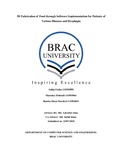3D fabrication of food through software implementation for patients of various diseases and dysphagia
Abstract
3D printing can be considered as a means of creating solid 3-dimensional objects using additive manufacturing with the aid of computer design software. With respect to time and newer technologies, 3D printing has advanced far more than we have ever anticipated. Though the potential of 3D printing has been under philosophical discussion for some time, creating food using 3D printers has always been a challenge. In order to print 3D food using 3D printing technology, a solid software is required that will count and personalize the nutrient information per patient and individual. In this research, a software has been developed that computes the required macronutrients according to the requirements per individual. Seven diseases have been outlined in this thesis and calculations for ingredients based on different ratios and equations have been made which have been derived after intensive research, from which two unique self-deduced algorithms have been developed to run the software logic. The system takes in the age, height, weight, gender and disease information from the hospital patients’ charts, uses the variables to run the first own algorithm to calculate personalized protein, fat and carbohydrate counts and then based on the diseases the software runs the second own algorithm to calculate the exact amounts of the ingredients required to prepare their meals per day. In this thesis, 3D models have also been designed to maximize user experience and the patient’s visual appeal for the food. The final output of the software is expected to print out a list of the ingredient count per day and display the selected 3D model. Further work of this thesis aims to explore the world of 3D printing and come up with nutrition specific solutions for people suffering from different diseases and have 3D printing technology make their lives easier because the potential of 3D printing of food is vast in a sense that it could provide an exciting alternative to help people customize their food, make them visually more appealing so that people requiring special care would be able to consume food with much more ease which would otherwise have been unachievable through conventional cooking and food preparation techniques

